The avalanche danger in the west central Montana Backcountry is rated Moderate today on open slopes steeper than 35 degrees that have not frozen overnight. The avalanche problem on these slopes is that it is possible to trigger a loose wet release. The avalanche danger is rated Low on all other terrain in the advisory area.
Good morning, this is Travis Craft with the West Central Montana Avalanche Center’s advisory for March 13, 2015. The danger rating does not apply to operating ski areas, is the sole responsibility of the U.S. Forest Service and expires at midnight tonight.
Avalanche and Weather Discussion
This morning mountain temperatures are below freezing in all of the advisory area except Hoodoo Basin and Sleeping Women Snotels.We have accumulated trace amounts of snow and rain in the last 24 hours. The winds are 15 mph and gusting 20 mph out of the NW.
The main avalanche concern is on open slopes >35 degrees that have not frozen overnight; it is possible to trigger loose wet releases. On slopes that did not freeze, the top 40 cm of the snowpack is rotten and triggering a loose wet slide is possible. With the forecasted high temperatures for today if the slope you are recreating on produces pinwheels or rollerballs it is time to change aspect. Pay attention to these bull’s-eye clues from the warming snowpack.
Dudley and I toured in the Rattlesnake yesterday, we had poor visibility with a variety of snow conditions. There was ice on windward slopes and rotten snow on leeward aspects at 7500 feet. The main concern we encountered was loose wet releases on unfrozen slopes. The deep persistent layer was reactive in compression tests but did not propagate in our ECT.
Tim was in the Lolo Pass area and his main avalanche problem was loose wet slides on steep slopes >35 degrees. The spring-like conditions are warming cornices, so be aware of cornice failures.
Ed and Casey were in the Lost Trail backcountry and had similar pit results on the persistent weak layer 35 cm into the snowpack. This layer failed in compression tests but had no propagation in ECT’s. The main concern is that on slopes that have not frozen overnight or that have warmed in the afternoon, it is possible to trigger a loose wet release.
When recreating in the backcountry on steep slopes look for the bull’s-eye clues: pinwheels, rollerballs and punching through the top layers of the snowpack. These are signs of instabilities in a warming snowpack and it is time to change aspects.
Weather and Avalanche Outlook
This weekend the high pressure is going to be replaced by a warm wet system which is forecasted to bring large amounts of precipitation. The weather models call for rain in the mountains of up to 2 inches. If these events happens then the avalanche danger will rapidly increase with the addition of rain or large amounts of heavy wet snow.
Steve Karkanen will issue the next regularly scheduled advisory on Monday, March 16.














